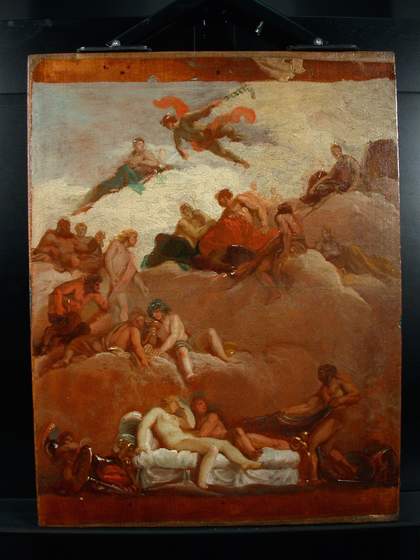
Fig.1
Louis Chéron 1660–1725
Vulcan Catching Mars and Venus in his Net c.1695
Tate
T00578
This painting is in oil paint on paper mounted onto canvas measuring 495 x 391 mm (fig.1). In the late 19th or early 20th century the paper was glued to a non-original canvas support (plain weave, linen on a four membered pine stretcher). Although making the object easier to handle, the lining has caused weave emphasis in the painting, and a few, linear cracks in the paint have developed along the stretcher bars. The pattern of the weave emphasis corresponds with the weave pattern of the current lining canvas.
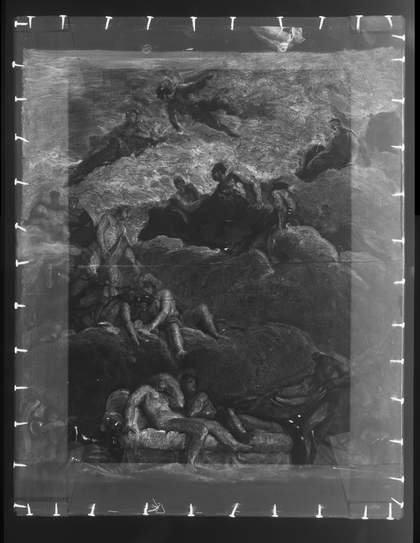
Fig.2
X-radiograph of Vulcan Catching Mars and Venus in his Net c.1695

Fig.3
Ultraviolet photograph of Vulcan Catching Mars and Venus in his Net c.1695 before the restoration of 2005
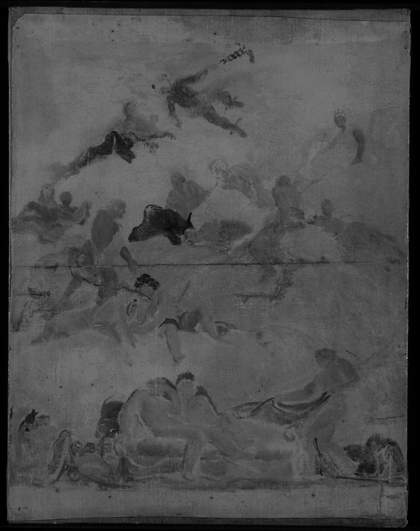
Fig.4
Infrared reflectogram
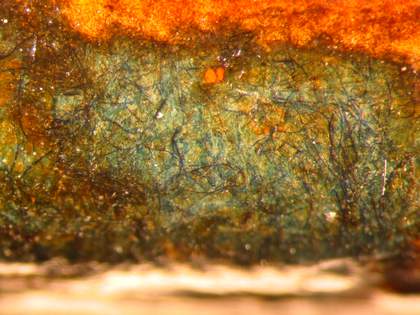
Fig.5
Photomicrograph of the blue paper reinforcing the fold in the paper support, photographed at x1.6 magnification
There is a straight, horizontal line running across the middle of the composition dividing the painting into two halves (figs.2–4). The top half measures approximately 244 mm high and the lower section approximately 249 mm high. This line could represent a join but is more likely to be a break or split caused by folding the paper. The split appears to have been reinforced at the back with a localised interleaf of blue paper, measuring about 70mm in width. The profile of this interleaf is visible on the surface of the painting, when viewed in raking light, giving that area a particular texture. Blue fibres are visible in the paper under magnification; it has been suggested that the interleaf represents a type of paper made from recycled blue wool (fig.5). It is worth noting that Chéron sketched the same subject on blue paper.
The X-radiograph (fig.2) reveals several linear tears and two complete losses to the paper support. The two, triangular losses run along the central split and have been filled and retouched. There are two short, linear tears running in from the left and the right edges and a series of branched cracks in the paper running roughly parallel below the central split. These have also been filled and retouched by later hands.
The bottom 28 mm and top 27 mm of paper support are painted red but are not part of the image, giving compositional dimensions of 438 mm by 391 mm. A subsequent, original application of off-white paint at this top margin is undefined and is not incorporated into the composition, although there is evidence that this area was once covered with retouching to enlarge the composition. It is interesting to note that there are the remains of blue paint along the very top edge of the paper support, suggesting that the painting has been extended at one time but the alteration was subsequently removed. The paper support also extends slightly over the right turnover edge for about 10 mm. Original paint extends over this edge (some sky, clouds, grey/blue armour) and this area has the red-brown preparatory wash (see ground).
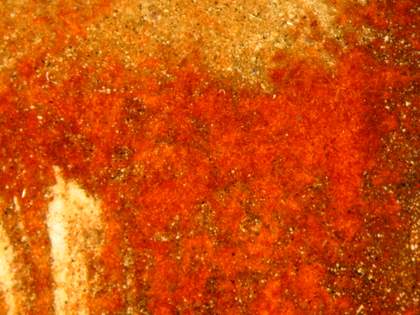
Fig.6
Photomicrograph at x0.8 magnification of the reddish brown wash on the paper (top central area of the image)
No conventional ground layer was found but the paper was toned with a reddish brown wash of thin oil paint prior to painting (fig.6). This would account for the dark colour of the paper support, which seems too extreme to be the result of a degraded paper stained with oil medium. Sampling of this layer showed the presence of sienna and a transparent red earth.1

Fig.7
Photomicrograph at 0.6 magnification of the dark brown paint reinforcing the outline of his forehead
No underdrawing is apparent. In the past it has been suggested that the composition was set down in an initial brown undermodelling, but where brown lines are visible they lie on top of the paint, reinforcing the outline of the figures (fig.7). There is no underpainting; the sketch is painted directly onto the support, almost entirely wet-in-wet in a single paint layer, apart from the instances described below.
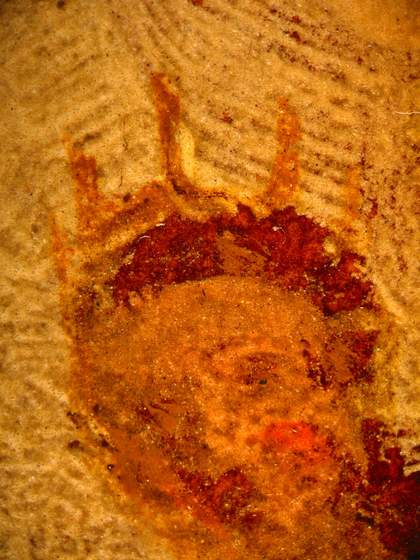
Fig.8
Photomicrograph at x0.8 magnification of the crowned head of the figure seated at the top right of the composition, showing reserve in the clouds for the main figure, with red paint added during painting for the spikes of the crown
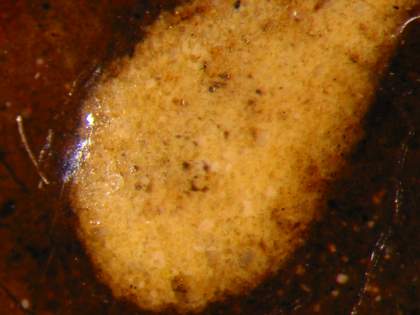
Fig.9
Photomicrograph at x3.2 magnification of a highlight in lead tin yellow on the gilt bed
The painting is an oil sketch for a ceiling design for Boughton House in Northamptonshire. Painting boldly in a direct technique, the artist set down the background paint of the clouds and sky with reserves for the figures and figure groups, often leaving the coloured paper exposed in these areas to stand as shadows. Any subsequent elaboration of these figures was then added on top of the paint of the surrounding sky and clouds, for example the crown of the uppermost seated figure at the right (fig.8) or the highlights on metal objects, added as final touches in lead white or lead-tin yellow (fig.9). The very confident placing of the figures, along with the absence of underdrawing, might suggest that Chéron was working from another sketch.
Chéron’s palette contains lead white, charcoal black, vermilion, burnt sienna, red earth, red lake and yellow lake, yellow ochre, lead-tin yellow, orpiment, verdigris, azurite, smalt, ultramarine, possibly ultramarine with the addition of much powdered glass as a drier or bulking agent. The pigment particles are large in size, particularly the lead white, and Chéron uses some interesting pigment mixtures, for example the admixture of verdigris to the greys and flesh tones.
The painting was cleaned and treated in 2005.
March 2020
